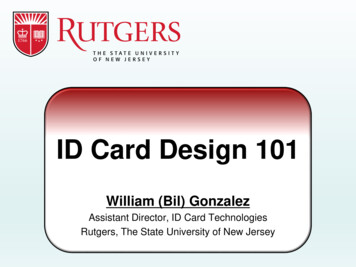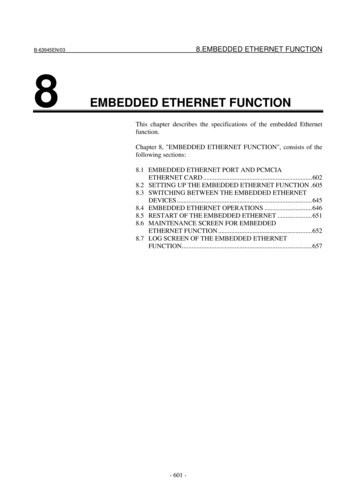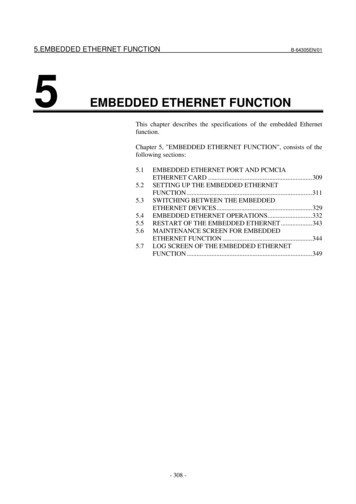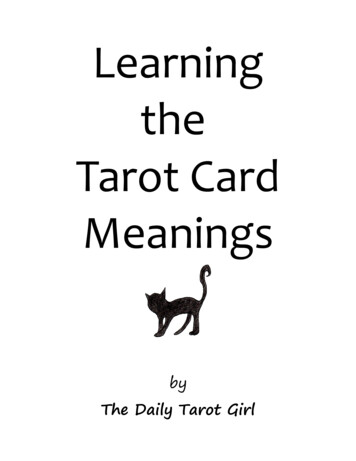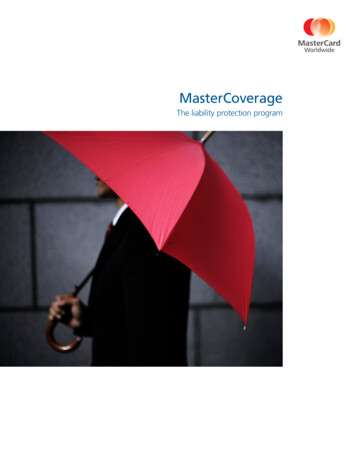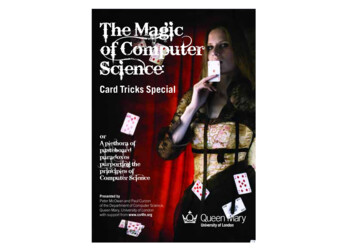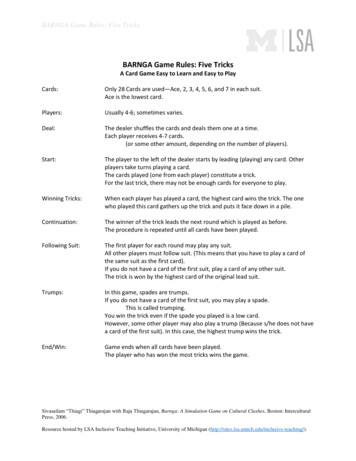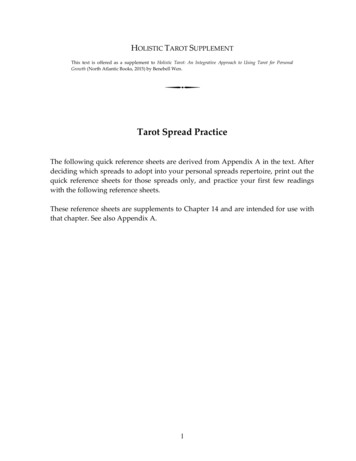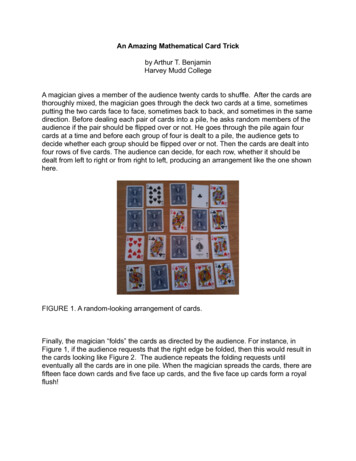
Transcription
An Amazing Mathematical Card Trickby Arthur T. BenjaminHarvey Mudd CollegeA magician gives a member of the audience twenty cards to shuffle. After the cards arethoroughly mixed, the magician goes through the deck two cards at a time, sometimesputting the two cards face to face, sometimes back to back, and sometimes in the samedirection. Before dealing each pair of cards into a pile, he asks random members of theaudience if the pair should be flipped over or not. He goes through the pile again fourcards at a time and before each group of four is dealt to a pile, the audience gets todecide whether each group should be flipped over or not. Then the cards are dealt intofour rows of five cards. The audience can decide, for each row, whether it should bedealt from left to right or from right to left, producing an arrangement like the one shownhere.FIGURE 1. A random-looking arrangement of cards.Finally, the magician “folds” the cards as directed by the audience. For instance, inFigure 1, if the audience requests that the right edge be folded, then this would result inthe cards looking like Figure 2. The audience repeats the folding requests untileventually all the cards are in one pile. When the magician spreads the cards, there arefifteen face down cards and five face up cards, and the five face up cards form a royalflush!
FIGURE 2. After folding the right row, the cards look like this.As we’ll explain, this trick practically works by itself, and the underlying mathematics issimple and elegant. To best explain its secret, we begin with a warmup trick, which iseven easier to perform, and also gets a strong audience reaction.Four Ace Surprise. A magician deals sixteen cards face down into four rows of fourcards apiece, then turns four of the cards face up, as in Figure 3.FIGURE 3. The initial layout of cards (with the four aces hidden on the main diagonal)Next the magician asks the audience to “fold in” the edges of the cards, as in theprevious trick. At the end of this procedure, after six folds, all sixteen cards will bestacked into one pile. When the magician spreads the sixteen cards, there will be twelve
face down cards, and four face up cards. The audience will be surprised to see that theface up cards are the four aces.The secret. The magician makes sure that the four aces begin on the main diagonal(top left corner to the bottom right corner). To achieve this, the magician could start withthe four aces in the first, sixth, eleventh, and sixteenth card in the deck, and then dealthe four rows of cards from left to right. An easier (and more deceptive) approach is tostack the four aces at the top of the deck, then haphazardly deal cards into “random”positions in the four-by-four grid, taking care that the aces are placed on the maindiagonal. The trick is now guaranteed to work by itself. After all the folding is done, thefour aces will be facing one direction and the other twelve cards will be facing theopposite direction. If the aces are face down, then the magician simply turns the stackof cards over before spreading them out.Why this trick works.This trick is a beautiful application of parity. Imagine the sixteen cards are dealt onto afour-by-four checkerboard with black and white squares. In the initial configuration ofFigure 2, the white squares are occupied by the four face up cards and the four aces(face down on the main diagonal), and the black squares are occupied by the remainingeight face down cards. After the cards are folded, all the cards will be stacked on asingle “destination” square.Suppose the destination square is black. Now since each ace begins face down on awhite square, every ace will be flipped an odd number of times on its way to thedestination, and will therefore end face up. By similar reasoning, the four face up cardsand the other eight face down cards will be face down at the destination. Likewise, if thedestination square is white, then it will contain four face down aces and all other cardswill be face up.Shuffled to your heart’s content. We are now ready to explain the trick described atthe beginning of the article. It is based on an idea presented in the card magic book,Dear Mr. Fantasy, by John Bannon. In this trick, I use the Ten, Jack, Queen, King, andAce of each suit from the deck, and ask my assistant to “Please shuffle these twentycards to your heart’s content.” After the cards I returned to me, I spread the cards faceup and deal the cards, two at a time into a pile on the table. But as I deal the cards, I putsome of these pairs face to face, some pairs back to back, and leave some pairs facingthe same direction. Next, I deal the cards into four rows of five. The cards look like arandom mix of face up and face down cards, like the one shown in Figure 1.We then go through the folding procedure that was done in the Four Ace Surprise. Afterall the cards have been folded into a single pile, I say “Now it would be amazing if, afterall this shuffling, flipping, and folding, all the cards were now facing the same direction.It didn’t happen here, but it would have been amazing. The reason they aren’t all in thesame direction is because you started this trick by shuffling these cards to your heart’scontent. And you did quite a nice job of it, because look what we have here.” Next I
spread the cards to to reveal that there are precisely five face up cards, namely 10 , J ,Q , K , A (in some order) as I say “.a royal flush in hearts!”The secret. After the cards are shuffled, and I go through the cards two at a time, eachpair has three possibilities:(i) Neither card is a heart(ii) Both cards are hearts(iii) Exactly one card is a heart.In case (i), the cards are dealt face to face. In case (ii), the cards are dealt back to back.In case (iii), the cards are both dealt face up, but the heart card must go second. Withcase (iii), if the heart is the first of the face up pair, then deal the two cards as a pair; ifthe heart is in the second position, then deal the two cards singly. Either way, the heartwill be the second card dealt into the pile. The trick now works by itself, just like in theFour Ace Surprise.Example. Suppose that after the assistant shuffles the cards, the cards appear in theorder given in Figure 4. Then after being dealt into a pile, the cards would be in theorder given in Figure 5. After being dealt into four rows of five, the cards appear as inFigure 1.FIGURE 4. The original shuffled twenty cards.
FIGURE 5. The new arrangement after the magician deals the cards, two at a time, intoa pile.Why this trick works. After the shuffled cards are dealt, two at a time, into the pile, let’ssay that the cards are in positions 1 through 20, as we go from top to bottom. Forexample, in Figure 5, the King of Spades is face down in position 1, the Ten of Spadesis face up in position 2, the Ten of Diamonds is face down in position 3, and so on.As a result of our dealing rules, regardless of whether we see case (i), (ii), or (iii), theheart cards must either be face up in an odd position or face down in an even position,and the non-hearts have the opposite situation (face down in an odd position or face upin an even position). Notice that this situation remains true even if a pair of cards isflipped over during the deal. Thus, to make the trick more interesting, as I deal each pairof cards, I will ask my assistant (or random members of the audience) if she wants thecards to be flipped or not. After dealing all the cards two at a time, I then go through thecards four at a time, and ask the assistant, for each group of four cards, whether thecards should be flipped or not. It still remains true that the hearts (and only the hearts)will be face up in an odd position or face down in an even position.Finally, as the magician deals the cards into four rows of five on an invisiblecheckerboard (with a white square in the upper left corner), each heart will either beface up on a white square or face down on a black square, and the non-hearts will havethe opposite situation. In fact, as long as you deal the cards onto the checkerboard sothe colors alternate, your hearts and non-hearts will be in the right positions. (I let myassistant decide if she wants the cards dealt left to right, right to left, in zig-zag order, oras a spiral. Note that the trick would not work if you dealt the cards from top to bottom.)As in the Four Ace Surprise, the folding procedure will automatically result in all thehearts facing one direction and the non-hearts facing the other direction.You can imagine variations of this trick using alphabet cards, number cards, or morecomplicated instructions. It’s a fun trick to perform for any audience, and I enjoyperforming it (and sometimes explaining it) for my discrete mathematics class. Eitherway, this trick is surely one that your audience should flip over.Acknowledgment. I am grateful to John Bannon for giving me permission to describehis trick in this article.References.The ideas behind this trick were developed and discussed by Henry Dudeney, BobHummer, Steve Freeman, Martin Gardner, John Bannon, and Lennart Green, asdescribed in Bannon’s book, Dear Mr. Fantasy, published in 2004. For moreapplications of these ideas, see the online article, Many Fold Synergies, l by Colm Mulcahy.
It is based on an idea presented in the card magic book, Dear Mr. Fantasy, by John Bannon. In this trick, I use the Ten, Jack, Queen, King, and Ace of each suit from the deck, and ask my assistant to “Please shuffle these twenty cards to your heart’s content.”
